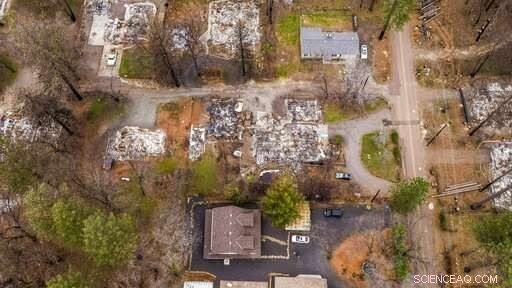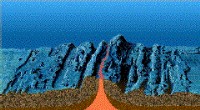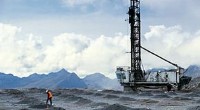Hvilke huse overlevede en naturbrand? Tit, dem, der er bygget til at kode

På dette billede taget 19. marts, 2019, Dawn Herr og hendes søn Liam, 8, besøge deres hjem i paradis, Californien, der overlevede lejrbålet. Herrernes hjem, bygget i 2010, blev brændt og havde røgskader indeni, så familien bor midlertidigt i det nærliggende Chico. Herrerne krediterer hjemmets overlevelse til strenge byggeregler og til grus, der omringede bygningen og holdt flammerne tilbage. (Hector Amezcua/The Sacramento Bee via AP)
Himlen var ved at blive orange, og gløderne fløj fra lejrbålet, da Oney og Donna Carrell og Donnas far skyndte sig væk fra deres Paradise-hjem.
"Jeg troede, 'Åh, godt, huset er færdigt, '" sagde Oney Carrell.
Et par dage senere, de lærte andet. Carrells' hjem overlevede den dødeligste og mest ødelæggende skovbrand i Californiens historie med et par skæve vinduesrammer, en delvist forkullet tud og en genstridig røglugt indeni.
Det meste af deres kvarter blev ødelagt. Et gæstehus i deres baghave, hvor Donnas far boede, blev lagt i aske, sammen med et par skure. Alligevel sad deres smukt restaurerede Studebaker fra 1940 uberørt i garagen.
Ødelæggelsesbuen, som lejrilden skar gennem paradiset, var tilsyneladende tilfældig:Hvorfor blev nogle huse reddet og andre forbrændt? Mens millioner af californiere forbereder sig på endnu en naturbrandsæson, en McClatchy-analyse af brand- og ejendomsregistre viser, at svaret kan findes i noget så simpelt som tagene over hovedet - og det år, hvor deres hus blev bygget.
En skelsættende byggekode fra 2008 designet til Californiens brandudsatte regioner - der kræver brandsikre tage, sidespor og andre sikkerhedsforanstaltninger - ser ud til at have beskyttet Carrells hjem og snesevis af andre kan lide det fra lejrbålet. Det år markerer et afgørende øjeblik i statens dødelige og dyre historie med destruktive naturkatastrofer.
Alt i alt, omkring 51 procent af de 350 enfamiliehuse bygget efter 2008 i lejrens sti var ubeskadigede, ifølge McClatchys analyse af Cal Fire-data og Butte County ejendomsregistreringer. Derimod kun 18 procent af de 12, 100 boliger bygget før 2008 slap for skader. Disse tal inkluderer ikke mobilhomes, som brændte næsten lige meget uanset alder.
"Det er gode standarder, de virker, " sagde senioringeniør Robert Raymer fra California Building Industry Association, der rådførte sig med statsembedsmænd om byggeloven.
Men på trods af denne lektion, Californien kan ende med at komme til kort i sin indsats for at beskytte hjem mod den næste naturbrand.
svampede byer som Folsom, hvor en 11, 000 boligbyggeri skyder frem, har mulighed for at omgå statens sikkerhedsstandarder på trods af betydelige brandrisici. Staten, som tilbyder kontante incitamenter til at styrke gamle hjem mod jordskælv, har indtil videre ikke gjort noget for at få californiere til at eftermontere boliger bygget før 2008 til brandsikkerhed.
Det har ikke hjulpet, at boligbyggeriet gik i et dybt dyk i 2008 og har været langsom med at komme sig. Raymer sagde kun 860, 000 boliger og lejligheder er blevet bygget i hele landet, siden koden trådte i kraft. Det er blot 6 procent af statens boligmasse.
Ifølge Cal Fire, så mange som 3 millioner hjem ligger inden for de forskellige "brandfarezoner" rundt om i staten. Dave Sapsis, en Cal Fire vildmarksbrandforsker, sagde, at der ikke er nogen måde at vide endeligt, hvor mange af disse huse blev bygget før 2008, men han mener "det er overvægten af dem, flertallet."
Situationen er værre i det landlige Californien, hvor boligbyggeriet halter, men brandfarerne er blandt de værste i staten, sagde Raymer. Færre end 3 procent af boligerne i lejrbålets vej blev bygget efter 2008.
"Det meste af vores inventar, der var her før branden, blev (bygget) mellem 40'erne og 70'erne, " sagde Paradise Town Councilman Michael Zuccolillo, en ejendomsmægler. "Det gennemsnitlige hjem her var fra 70'erne."
Det efterlader tusindvis af hjem i fare for det næste inferno på tværs af Californien, deres træ-shake helvedesild venter på at antændes.
"Hvad skal vi gøre ved den eksisterende boligmasse, der er blevet bygget de her steder?" sagde Max Moritz, en naturbrandspecialist ved UC Santa Barbara. "For den eksisterende boligmasse, der er derude, der ikke er bygget til disse koder, vi har et massivt eftermonteringsproblem på vores hænder. De har strukturantændelsessårbarheder, der er indbygget i situationen, de er bagt ind i problemet."
'Det svageste led'
The Carrells, bor nu i et lejemål i Roseville, tegnede deres Paradise-hjem og lavede meget af det indvendige arbejde selv; de vidste, at hjemmet var bygget med brandsikkerhed i tankerne.
"Jeg vidste, at vi var midt i skoven, " sagde Oney Carrell under et nyligt besøg i Paradise. "Hvorfor ville du ikke gøre alt, hvad du kunne for at få det til at holde?"
Men selv han er overrasket over, at deres hjem klarede det. At træde over et mørklagt terrasseafløb kun få meter fra bagsiden af huset, han undrede sig højt:"Jeg ved ikke, hvorfor det stoppede her."
Det er næsten umuligt at sige med sikkerhed, hvorfor nogle hjem stadig står i paradis, mens andre blev ødelagt. Landskabspleje spillede sikkert en rolle; brandeksperter siger, at boliger bufret af såkaldt "forsvarligt rum" sandsynligvis klarede sig bedre end dem, der er pakket ind i buske. Held var en stor faktor, også, da hjem uden tvivl blev skånet af sidste sekunds skift i vinden.
Alligevel, eksperter siger, McClatchys analyse styrker deres tro på, at Californiens brandsikre byggekodeks kan gøre en forskel i en æra med stigende sårbarhed. Daniel Gorham, en tidligere brandmand og US Forest Service-forsker, der arbejder for Insurance Institute for Business &Home Safety i South Carolina, sagde, at Californien-koden er ved at blive en model for andre brandudsatte stater.
"Californien er med stormskridt foran andre dele af landet, " sagde Gorham. "Californien er på forkant."
Fortalere siger, at brandsikre byggematerialer ikke er særlig dyre. En undersøgelse sidste efterår af Headwater Economics, et konsulentfirma i Bozeman, Mont., fandt ud af, at "et nyt hjem bygget til naturbrandsikre koder kan bygges til nogenlunde samme pris som et typisk hjem."

I denne 19. marts, 2019, Sean og Dawn Herr samler et amerikansk flag, der overlevede Camp Fire sammen med deres paradis, Californien, hjem. Herrernes hjem, bygget i 2010, was scorched and had smoke damage inside so the family is living indefinitely in nearby Chico. The Herrs credit the home's survival to strict building codes and to gravel that encircled the building and kept the flames back. (Hector Amezcua/The Sacramento Bee via AP)
But getting Californians to retrofit homes built before 2008 is an enormous task. The state requires property owners in fire zones who replace at least half their roof to install "fire-retardant" materials on the entire roof. Other than that, imidlertid, there's nothing forcing Californians to safeguard their existing homes against fire hazards.
A few California cities have taken matters into their own hands. I 2008 the City Council in Big Bear Lake, a community of 5, 200 in San Bernardino County, passed an ordinance declaring wood shake shingle roofs "a severe fire hazard and danger" and ordered homeowners to replace them by 2012. Armed with state and federal grants, it offered cash incentives of up to $4, 500 apiece for new roofs.
Although the grant program has run out, "I can't think of the last time I saw a shake roof in Big Bear, " said Patrick Johnston, the city's chief building official.
Most Californians, imidlertid, are on their own when it comes to spending the tens of thousands of dollars needed to replace a roof or install fire-resistant siding. The state offers no financial incentives for fire safety the way it does, sige, for earthquakes—homeowners in quake zones can get up to $3, 000 apiece from the state to gird their homes against seismic disaster.
Der er tegn, imidlertid, that the state is beginning to get more serious about retrofitting homes for fire safety.
A law signed last year by former Gov. Jerry Brown requires the state fire marshal to develop a suggested list of "low-cost retrofits" by January 2020. The state would then promote these retrofits in its education and outreach efforts.
California also might start throwing cash at the problem.
A new bill, AB 38, introduced earlier this year by Democratic Assemblyman Jim Wood of Santa Rosa, would create a $1 billion "fire hardened homes revolving loan fund" to help homeowners retrofit their properties.
The issue is personal for Wood, a dentist who spent weeks helping identify victims from the Camp Fire and the wine country fires of October 2017. Although eligibility terms haven't been spelled out, the bill would offer low-interest and no-interest loans to help those who otherwise couldn't pay for new roofs or other safeguards.
"A lot of these small towns are not as well off financially, " he said. "We need to find a way to help them, especially if they're poorer."
The fund might not be nearly enough to go around—not with hundreds of thousands of homes in need of retrofits, and a new roof alone costing $10, 000 eller mere. "The $1 billion, Ja, that's not enough to rehab every home, " said the Building Industry Association's Raymer. But he said it's "an absolutely excellent way to kick things off."
Wood said state officials would have to figure out a plan for parceling out the money to where it's needed most—probably starting with lower-income areas near forests.
"Obviously we want to affect the areas with the highest risk first, " the assemblyman said. "A lot of these small towns are not as well off financially. We need to find a way to help them, especially if they're poorer."
Mapping 'Severity Zones'
The fire-safe building code had its origins in two significant fires from a generation ago—the Panorama Fire of 1980, which spilled out of the mountains into the city of San Bernardino; and the monstrous Oakland Hills Fire of 1991, which wiped out 2, 500 homes and killed 25 people.
Som svar, the Legislature ordered the Department of Fire Protection and Forestry to start mapping major fire risks in California, in the hinterlands as well as urban areas. The result was a collection of maps of the state's "fire hazard severity zones, " encompassing more than one-third of California's land mass.
Based on factors such as terrain, vegetation and weather patterns, the zones represent Cal Fire's attempt to predict the probability of a fire starting and the likelihood that it could become significant, said Cal Fire's Sapsis.
The maps spawned tighter building standards. The Legislature mandated fire-resistant roofs in these fire-prone areas. Then in 2008 the state laid out a more comprehensive scheme. The California Building Standards Commission rolled out a suite of regulations, known as Chapter 7A, that set strict rules for roofing materials, siding, windows, decks and other elements of a home built in 2008 or later—right down to the minimum specs for the wire mesh that must be installed on attic vents to keep embers out (no more than a quarter-inch of space between the wires).
Experts said the regulations seem to be particularly effective at protecting structures from the types of wildfires that are increasingly common in California, where wind gusts can blow embers a mile or two ahead of the main wall of flames and do some of the worst damage.
"A window breaks, a vent breaks, the fire gets into your home and you've got an interior structure fire, " said Joe Poire, the city of Santa Barbara's fire marshal.
Enforcement of the building code carries a few wrinkles. In the mainly rural areas where Cal Fire is in charge of fire protection, the Chapter 7A code is automatically enforced in any region that Cal Fire has designated as a "severity zone"—moderate, high or very high.
In urban areas that have their own fire departments, the code is generally used only in spots where Cal Fire says the threat is very high. Local governments have the discretion of rejecting the Cal Fire designation, and Sapsis said some city councils have been squeamish about the state's maps because of fears that the Chapter 7A code will inflate construction costs, or for other reasons.
Yet interviews with local officials throughout California by McClatchy indicate that the vast majority of cities and towns go along with Cal Fire's recommendations. Santa Barbara city officials extended the building code to coastal areas that had been overlooked by Cal Fire's mappers. The map omits small portions of Paradise, but the building code is enforced across the entire town, said Paradise public information officer Colette Curtis.

In this March 19, 2019 foto, an aerial image shows the home of Sean and Dawn Herr, bottom center, i paradis, Calif. The Herr home, built in 2010 to new fire-resistant building standards, survived the fire while nearby homes burned. (Hector America/The Sacramento Bee via AP)
Danger In Santa Rosa, Folsom?
Alligevel, there are places where local officials are reluctant to impose strict building codes—even where fire has caused catastrophe.
Before Paradise exploded, Santa Rosa's Coffey Park was the poster child for recent California wildfire disasters:Five people died and 1, 321 homes were destroyed by the Tubbs Fire in October 2017.
Coffey Park wasn't subject to California's Chapter 7A building code. It still isn't.
Unlike some areas of Santa Rosa, the neighborhood hasn't been designated a "very high fire hazard" zone by Cal Fire. City officials are OK with that. Although developers rebuilding Coffey Park are being urged to consider fire-resistant materials, city spokeswoman Adriane Mertens said the city doesn't see any reason to impose the 7A code in the neighborhood.
"There were very, very high winds that night, " Mertens said. "There were embers that were blown across the (Highway 101) freeway, across six lanes of freeway, into Coffey Park."
Jack Cohen, a fire scientist in Montana who helped develop the 7A code, said he thinks Santa Rosa is committing "an error in judgment" by rebuilding without the safeguards.
In any event, Cal Fire is updating its fire hazard maps over the next year or so, taking into account more sophisticated data on wind and other climate factors, and Sapsis said spots such as Coffey Park could wind up designated as high-risk areas. Once the maps are done, any region placed inside Cal Fire's "very high fire" zone will have no choice but to comply, under a bill signed into law by Brown last year.
But there will still be ways for cities to skirt the state building code.
Look at Folsom, widely considered one of the most vulnerable places in greater Sacramento to fire. The county's hazard mitigation plan says 44, 000 residents of Folsom are already at "moderate or higher wildfire risk."
Now the suburb is building a development called Folsom Ranch, eventually to be home to 25, 000 mennesker, on a parcel south of Highway 50.
The development is on land that used to be subject to the strict state building code. Now it isn't.
How did that happen? For år siden, the land was outside Folsom's city limits and Cal Fire was responsible for its safety. Cal Fire's maps put the land in the "moderate" risk zone—a threat level high enough that, under the state's regulations, the fire-safe building code took effect. As it happened, no construction took place during that time, city officials say.
The situation changed when the city annexed the land to forge ahead with Folsom Ranch. Because the land has never been in the state's "very high" risk zone, the city feels comfortable letting Folsom Ranch develop without the Chapter 7A building code.
Fire Chief Felipe Rodriguez said Folsom officials are still open to "the possibility of strengthening, hardening, our future homes." But for now, the city is only requiring homeowners' associations to implement a "vegetation management" plan and install fire-resistant fencing around properties that abut open space areas, Rodriguez said.
Is Folsom courting danger? Rodriguez doesn't think so. The city will build two fire stations in the development and will "be able to suppress a fire during its early stages, " han sagde.
'Sticks In A Fireplace'
The hundreds of thousands of older homes in fire zones aren't just more vulnerable in their own right.
Experts say they spread danger to new homes built to stricter standards.
"One little house built to a new standard, surrounded by a bunch of older stuff, is likely to get swamped, " Sapsis said.
Paradise provided a grim reminder of that problem. The Camp Fire destroyed more than 80 percent of the 4, 100 mobile homes in its path, whether they were built to the new code or not, according to McClatchy's data analysis. That isn't surprising, Sapsis said, given that many of Paradise's mobile homes were jammed alongside one another in mobile home parks.
"They're stacked so close together, they're like sticks in a fireplace, " Sapsis said.
Sapsis and others say the lesson is that strong building codes aren't enough. I særdeleshed, experts say communities must pay more attention to how they lay out their neighborhoods, allowing for firebreaks and enough space between houses.
"In the name of affordable housing, we're moving housing closer and closer to one another, " said Chris Dicus, a forestry and fire expert at Cal Poly, San Luis Obispo. "That serves to have house-to-house-to-house ignition."

In this March 19, 2019 foto, Oney and Donna Carrell stand near the ashes of her father's house in Paradise, Calif. Their property had two homes on it before the fire, but the only one to survive visible behind them was built to fire-resistant standards that went into effect in 2008. (Hector Amezcua/The Sacramento Bee via AP)
The problem isn't limited to densely-packed urban areas. "I live in a rural community, and I have got six feet basically separating me from my neighbor, " said Dicus, who lives outside of Morro Bay.
Ud over, experts say California is struggling to enforce the state law regarding "defensible space" around properties.
The law requires that property owners maintain as much as 100 feet of defensible space around homes and other buildings in and around "a mountainous area, forest-covered lands, brush-covered lands, grass-covered lands, or land that is covered with flammable material." That means keeping trees and shrubs pruned and spaced far apart. Within five feet of the building, property owners are supposed to remove anything that could catch fire:mulch, planter, woodpiles and so on.
I praksis, imidlertid, enforcement of the defensible space law has been spotty at best. Raymer, of the California Building Industry Association, said most property owners don't understand how to maintain their yards. The state doesn't impose penalties for non-compliance, and only a few local governments have chosen to do so, Raymer said.
Legislation could change that. SB 190, by Sen. Bill Dodd, D-Napa, would require the state fire marshal to develop a "model defensible space program, " including penalties, that local governments could adopt.
The problem extends beyond homeowners' property lines. Gov. Gavin Newsom, finding some rare common ground with the Trump administration, is advocating for more aggressive management of forested lands.
A thinned forest northeast of Paradise provided one of the rare victories of the Camp Fire. As the fire raged out of the tiny community of Pulga, it essentially spared the northern part of Magalia. The reason was a series of forest-thinning projects conducted in recent years and overseen by the U.S. Forest Service, Sierra Pacific Industries and the volunteer Butte County Fire Safe Council. The council also worked diligently with area residents to clear brush from their property.
All that work "did exactly what we hoped it would do, " said Calli-Jane DeAnda, executive director of the council, which secured $1 million in grants to remove fuels from forested areas. "This investment of public money is so worth the effort."
The Paradise 'Lab Experiment'
The rebuilding of Paradise means thousands of homes are going to be constructed in the coming years to the stricter standards promulgated by the state in 2008. It represents the single largest test of the effectiveness of the building code.
"That is an absolute lab experiment for us, " Sapsis said.
On the streets of Paradise, selvom, community leaders are taking a more measured view. Zuccolillo, the town councilman, said asphalt roofs and stucco siding might "give us more of a chance" but he doubts they will guarantee Paradise's safety.
"I saw metal buildings, metal and stucco buildings, burn to the ground, " han sagde.
Stadig, there's plenty of evidence, all over Paradise, that the state's building code can protect property.
The other day, Sean Herr pulled into his driveway on the west side of Paradise, where he and his wife Dawn were raising their two young children.
The first thing he did was bring out the ultimate symbol of resiliency:an American flag, the same one that flew on his front porch the day of the Camp Fire.
Like the flag, the house is still standing. The Herrs' home, built in 2010, suffered a bit of scorching and some interior smoke damage—the smoke is bad enough that they're still temporarily living in Chico and aren't certain they'll move back.
Stadig, they marvel at what a close call they had. A Ford Excursion and a boat parked in the front yard, just a few feet from their porch, blev ødelagt. Five motorcycles locked in a shed behind the house got ruined. Most of their neighborhood is gone.
The Herrs believe their attention to defensible space—the house is mostly encircled in gravel—and the strictness of the building code probably made the difference.
"Our yard and the construction of the house saved it for sure, " Dawn Herr said, gesturing to a small scorch mark by the side of the house. "You can see it tried to catch on fire."
© 2019 The Associated Press. Alle rettigheder forbeholdes.
 Varme artikler
Varme artikler
-
 Forskere finder, at seismisk billeddannelse er blind for vandMIT-forskere finder, at seismisk billeddannelse er blind for vand, som kan hjælpe forskere med at genfortolke strukturer i Jorden, herunder ved midocean-rygge, hvor man troede, at magma, vælder op fra
Forskere finder, at seismisk billeddannelse er blind for vandMIT-forskere finder, at seismisk billeddannelse er blind for vand, som kan hjælpe forskere med at genfortolke strukturer i Jorden, herunder ved midocean-rygge, hvor man troede, at magma, vælder op fra -
 Over 100 brandforskere opfordrer det amerikanske vest:Spring fyrværkeriet over denne rekordtørre 4…Kredit:Pixabay/CC0 Public Domain Hedebølgen, der ramte det nordvestlige USA og Canada, har slået rekorder i stykker, med temperaturer 30 grader Fahrenheit eller mere over det normale. Med tørke, d
Over 100 brandforskere opfordrer det amerikanske vest:Spring fyrværkeriet over denne rekordtørre 4…Kredit:Pixabay/CC0 Public Domain Hedebølgen, der ramte det nordvestlige USA og Canada, har slået rekorder i stykker, med temperaturer 30 grader Fahrenheit eller mere over det normale. Med tørke, d -
 Kan svampe faktisk hjælpe med at redde planeten?En lang række startups ser svampe som en miljømæssig game-changer-i stand til at erstatte noget plast, bruges i kødfrit kød, og endda spise gennem affald. © Santiago Urquijo/Getty Images På college,
Kan svampe faktisk hjælpe med at redde planeten?En lang række startups ser svampe som en miljømæssig game-changer-i stand til at erstatte noget plast, bruges i kødfrit kød, og endda spise gennem affald. © Santiago Urquijo/Getty Images På college, -
 Hvordan fungerer naturgasboring?Hvor meget ved du om naturgas? Keith Wood/Corbis Når du tænder din ovn eller tænder for din gaskomfur og bruger varmen fra den lille blå flamme, du gør, hvad folk i 62 millioner andre amerikanske hje
Hvordan fungerer naturgasboring?Hvor meget ved du om naturgas? Keith Wood/Corbis Når du tænder din ovn eller tænder for din gaskomfur og bruger varmen fra den lille blå flamme, du gør, hvad folk i 62 millioner andre amerikanske hje
- Sådan opretholdes Alkalinity i Wastewater
- Google hævder, at deres kortsigtede vejrudsigter er mere nøjagtige end avancerede modeller
- Dalian kohærent lyskilde afslører stærke isotopeffekter i fotodissociation af vandisotopolog
- Ohio -kritikere håber, at flagermus kan bremse rørledningsprojektet
- Sådan bygger man en kran til et skoleprojekt
- Forskere optrævler mysteriet om ikke-kotektiske magmatiske klipper


